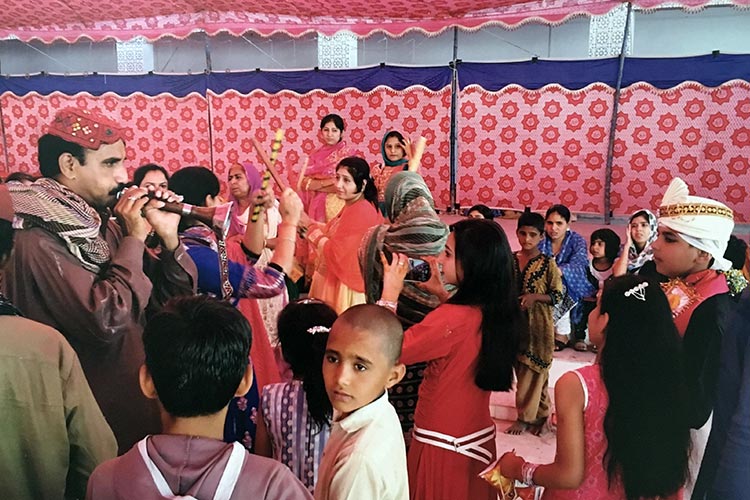Written by: Sania Ahmed Khan
Posted on: November 13, 2018 |  | 中文
| 中文
A figurine of Jhulelal in the Jhulelal Mandir, Ghulamullah, Sindh
According to various historical texts, Jhulelal or Udero Lal, is said to have lived in the subcontinent, in the 18th century. Sindhi Hindus consider him as an incarnation of the highly revered deity Varuna, while Sindhi Muslims believe that although born Udero Lal, the saint later converted to Islam, and was renamed Sheikh Tahir.
As the legend goes, Mirkh Shah, the tyrannical ruler of Thatta, ordered the local Hindus to convert to Islam. Taking refuge near the river Indus, they prayed for help until a vision of Varuna appeared. He told them that their savior would be born to an aged couple living nearby in Naserpur. This child was named Udero Lal and also 'Jhulelal,’ due to a tale that his cradle could swing on its own. On growing up, Jhulelal peacefully resisted the authority of Mirkh Shah, and convinced him to permit the Hindus to live in Sindh.
The Udero Lal Research Project (ULRP) was launched in January 2016, by French researcher Michel Boivin, who teaches at the Centre for South Asian Studies (EHESS, Paris). Other participating scholars included Zahida Jatt (anthropologist, University of Sindh, Jamshoro), Kamran Kumbher (historian, EHESS) and Masooma Shakir (architect, N.E.D. University, Karachi). The project aims to understand the processes through which these religious communities of Sindh co-exist, and whether there is a shared religious culture, with the figure of Udero Lal at its centre.
Recently, a seminar and photo exhibition was held at Alliance Française de Karachi, to shed further light on the project. In the early phases of the project, the team surveyed eleven sites devoted to Jhulelal in southern Sindh. While shrines devoted to Jhulelal can be found all over the world, Michel Boivin’s team selected the sites at Udero Lal and Tando Adam as the focus of their research, since both exhibited some degree of shared religious culture.
The shrine at Udero Lal village, 60 km north of Hyderabad, is of considerable importance, since both Muslims and Hindus visit it. The former believe the saint interred there is Udero Lal, while the latter believe its Sheikh Tahir. As discussed by Masooma Shakir, the very architecture of this shrine, which has elements of Central Asian architecture and specific spaces for Muslims and Hindus, reflects its flexibility as a place where followers of both religions are welcome.
The shrine at Tando Adam Khan, named Jhulelal, was one that the team came across unexpectedly during the course of their fieldwork. While Jhulelal is an alternate name for Udero Lal, it is also the moniker of the Sufi Lal Shahbaz Qalandar, whose main shrine is located in Sehwan Sharif. At Tando Adam, the Hindu community has built a miniature replica of Lal Shahbaz Qalandar’s mausoleum. Each year, they also celebrate his death anniversary. Nevertheless, the shrine remains a purely Hindu space, with surrounding buildings dedicated to deities such as Shiva. By celebrating a Sufi mystic in a Hindu space, a shared sacred space has yet again been created.

While the legend and imagery surrounding Udero Lal/ Jhulelal/ Sheikh Tahir is fascinating in itself, his figure as well as the multiple shrines are far more significant due to the message of peace and tolerance they symbolize. In a world where religious differences are increasingly leading to violence, these shared sacred spaces give us hope that interfaith harmony is indeed possible.
You may also like: